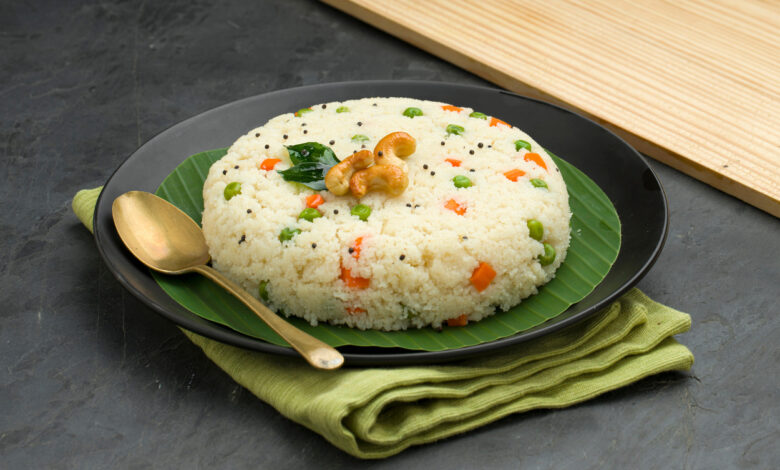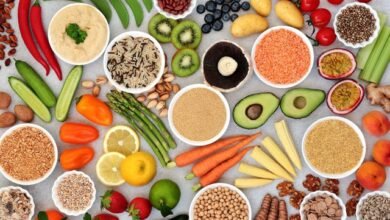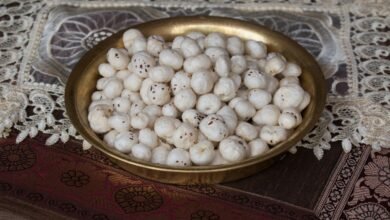Is Upma Good For Weight Loss? Let’s Dig In

Upma is a popular breakfast preparation that originated in South India. It is lower in calories than traditional Indian breakfast dishes such as puri bhaji, paratha, or dosa, making it an ideal food if you are aiming to lose weight. A serving of upma provides around 150-200 calories. Semolina, the main ingredient in upma, is a good fibre source with high satiety. In addition, upma is versatile as it contains vegetables that provide additional fibre, vitamins, and minerals, making it a more nutritious and filling meal.
Breakfast is an important meal, especially when trying to lose weight. However, choosing a healthy breakfast can be challenging. With several options available, one may find it difficult to decide what to eat. And this is where upma comes to the rescue.
Upma is one of the most available breakfast choices all over India. Upma is also known as Uppittu. Apart from semolina, one can also use cracked wheat, ragi, rice flour, quinoa, or oats to prepare upma.
Now, the question is, does upma help with weight loss? Does it work? This article will help find an answer.
Upma and Weight Loss: The Connection
The most beneficial part of consuming upma for breakfast is that it keeps you active throughout the day. It is primarily because vegetable upma has fibre-rich, nutritious vegetables. In addition, iron is abundant in upma. Consuming upma is a simple approach to providing your body with iron, a crucial mineral for health.
Upma contains fibre, vitamins, and good fats. It is a nutritious dish that supports a balanced diet. Upma is an excellent option for a weight-loss meal because it digests slowly and makes you feel full. It can be a massive help in your weight-loss efforts.
Different Types of Upma
Cracked Wheat Upma
This healthy and nutritious breakfast option is made from cracked wheat, which can aid in weight loss for a few reasons. First, it is a high-fibre food. It contains soluble and insoluble fibre, which helps regulate digestion and promote feelings of fullness.
Shalika’s Incredible Weight Loss Journey – Lost 38 kgs in 12 Months
Chat with us to get started on your health and fitness journey >> https://hlfy.me/YT_Video
Wheat upma is low-fat when prepared with minimal oil. Therefore, reducing their calorie intake and losing weight is a good option. Wheat upma is also a good protein source. As a result, it can help build and repair muscles.
Finally, wheat upma, prepared with vegetables like carrots, peas, and onions, provides essential nutrients like vitamins, minerals, and antioxidants.
Suji/semolina Upma
Semolina, also known as suji or rava, contains an abundant amount of minerals, many of which are beneficial to us. It aids in the production of proteins as well. It aids the synthesis of DNA and RNA and the metabolism of amino acids. Selenium, an antioxidant that guards against the oxidation of DNA cells, is abundant in semolina. Hence, it reduces the risk of several diseases. In addition, semolina includes protein. Therefore, incorporating it into your diet helps you lose weight.
Nutritionists advise upma for weight loss because, although being high in carbohydrates, suji has no cholesterol, making it suitable for regular consumption. Additionally, veggies added to upma are a great source of fibre. As a result, upma aids in weight loss.
Ragi Upma
Ragi is known as a wonder grain for losing kilos. Iron, calcium, and dietary fibre are abundant in ragi upma. Studies show ragi is high in fibre. Since ragi contains a lot of fibre, it keeps you full and prevents you from having cravings. By doing this, you can lose weight.
Tryptophan, a particular class of amino acids found in ragi, aids in weight loss. You feel less hungry because tryptophan suppresses your appetite.
Oats Upma
One of the world’s healthiest grains is oats. According to research, oats are an excellent choice for weight loss. It stimulates satiety hormones causing you to consume fewer calories, which may lower your risk of obesity. For individuals looking to lose weight, oats upma is an excellent option. It is high in protein, packed with soluble fibre, essential vitamins and minerals, and low in fat.
Dalia Upma
Dalia has a low-calorie count, a low GI, and a high protein and fibre content, making it an excellent choice for weight loss. For those attempting to reduce processed grain consumption, dalia is a fantastic option. It also fills you up for longer and is considered an excellent weight-loss dinner option.
Quinoa Upma
It contains carbohydrates, magnesium, and protein, which includes all nine essential amino acids. Your risk of diabetes and heart disease decreases because of the fibre content in quinoa. In addition, it can reduce cholesterol and blood sugar levels. Research suggests antioxidants included in quinoa can protect your heart and other organs from damage. Investigations show quinoa is a good source of dietary fibre. Its fibre keeps you full for a very long period. Therefore, it is ideal for those who are watching their weight.
Summary
Upma made from cracked wheat, semolina, ragi, oats, dalia, and quinoa are all high in fibre, low in fat, and contain essential nutrients. Additionally, they promote feelings of fullness and reduce the risk of several diseases.
Healthy Weight-loss-friendly Upma Recipes
Semolina/sooji Upma
Servings: 2
Total time: 15 minutes
Ingredients
- Semolina (sooji): ½ cup
- Ginger (finely chopped): ½ inch
- Onion (finely chopped): 1
- Green chilli (finely chopped): 1
- Black mustard seed: 1 tsp
- Curry leaves: 4-5
- Oil: 2 tsp
- Salt: to taste
- Lemon juice: 1 tsp
- Coriander leaves
Method of Preparation
- In a hot pan, dry roast suji over medium flame until light brown in colour
- Heat some oil in a pan. Then, add mustard seeds and curry leaves.
- Add the onions and cook until transparent. Next, add the ginger and cook for 2 minutes. Then, add the salt and ½ cup of water. Then, bring the mixture to a boil and gradually add sooji.
- Stir it constantly to avoid lumps.
- Cover and cook for a few minutes. Add lemon juice and mix well.
- Add coriander leaves and serve hot.
2. Oats Upma
Servings: 4
Total time: 20 minutes
Ingredients
- Oats: 1 cup
- Oil: 2 tsp
- Onion: 1 (chopped)
- Tomato: 1 (chopped)
- Curry leaves: 6-8
- Ginger (finely chopped): 1/2 inch
- Green chilli (finely chopped): 1
- Mustard seeds: ½ tsp
- Salt: to taste
- Cumin seeds: ½ tsp
- Water: 3 cups
- Lime juice: 1 tsp
- Mixed vegetables (beans, peas, carrots, cauliflower): 1 cup (chopped)
- Coriander leaves finely chopped: 1 tbsp
Method of Preparation
- Dry roast oats for 2 minutes in a hot pan.
- Now remove it from the pan and set it on a dry, clean plate
- Heat oil and add mustard and cumin seeds.
- Next, add ginger, green chillies, and curry leaves to the pan. Add the chopped vegetables and cook for 3 to 4 minutes over medium-low heat.
- Add water and salt, and bring it to a boil.
- Add roasted oats, stirring continuously.
- Cover and cook until the oats have absorbed all the liquid. It’ll take three to five minutes.
- Add some lemon juice and some finely chopped coriander and mix well.
- Serve warm.
Risks of Overconsumption
You should avoid the consumption of semolina if you have gluten intolerance or Celiac disease, as it may cause bloating, constipation, or other unpleasant side effects. Likewise, one should not consume it if one is aware of any allergic reactions brought on by it because it might cause several health issues.
Foods to Pair with Upma to Make it Healthier
- A creamy and flavorful chutney made from coconut, green chillies, ginger, and other spices. It pairs well with upma and adds healthy fats to the meal.
- Sambar is a popular vegetable and lentil stew rich in protein and fibre. Pair it with Upma to add some texture and nutrition to the meal.
- Pair it with Raita. Raita is a refreshing yoghurt-based side dish, and you can make it with cucumbers, onions, and spices. Adding protein and probiotics to your healthy plate is a great way. Also, it is ideal in summer as the coolness of the raita balances out the heat of the upma.
- A simple and refreshing salad made with chopped tomatoes, onions, cucumber, salt, pepper and lemon adds some crunch and freshness to the meal. In addition, a salad is a powerhouse of vitamins and minerals.
- You can roast vegetables like carrots, zucchini, bell peppers, and eggplant in the oven with olive oil, salt, and pepper. Also, this is a great way to break the monotony and add a touch of fusion to a regular staple. The roasted vegetables add some sweetness and smokiness to the flavours of the upma.
Summary
You can add some healthy and flavorful food options to pair with upma. These options include coconut chutney, sambar, raita, salad, and roasted vegetables. Adding these dishes to upma can add texture, nutrition, and variety to the meal.
HealthifyMe Suggestion
Upma digests gradually and makes you feel full. So if you like a snacky dinner, upma is a fantastic choice. In addition, your weight loss efforts may benefit significantly from it. Combine upma with curd and salad, and you have an innovative dinner combination.
The Final Word
Upma can be an excellent addition to a weight-loss diet for several reasons. It contains semolina, which is a whole grain that is rich in fibre and protein. They keep you fuller for extended periods, reducing your overall calorie intake. Some upma preparations contain vegetables such as onions, tomatoes, and peas, which provide essential vitamins and minerals. Lastly, you can make upma with wheat, oats, and quinoa, making it easy to include in your diet regularly. However, it is crucial to remember that portion control is vital for weight loss. Therefore, be mindful of your serving sizes when consuming upma.
Disclaimer: The purpose of this article is just to disperse knowledge and raise awareness. It does not intend to replace medical advice from professionals. For further information, please contact our certified nutritionists Here.
Frequently Asked Questions (FAQs)
Q. What is upma?
A. Upma is an Indian breakfast meal most popular in Kerala, Telangana, Karnataka, Andhra Pradesh, Tamil Nadu, and Maharashtra. It is a thick porridge made from dry-roasted semolina. However, depending on individual preferences, one uses oats, wheat, quinoa and several other ingredients to make the upma of their choice.
Q. Is upma good for weight loss?
A.Upma is an excellent choice for weight loss because it digests slowly and helps you feel full. It is a nutrient dense food that contains vitamins and minerals..
Q. How many calories are in a serving of upma?
A. Upma is an excellent breakfast option. It only has 86 calories per 100 grams. One serving of upma provides 185 calories.
Q. What are the health benefits of upma?
A. Upma is a nutritious option for all age groups because it contains proteins, carbohydrates, vitamins, minerals, zinc, phosphorus, and iron. Upma keeps you fuller for a long time. In addition, the nutrients in upma maintain and improve the condition of your kidneys, heart, bones, and immune system.
Q. Can upma be part of a healthy diet for weight loss?
A. Yes, eating upma helps you lose weight. You can also choose healthy options like ragi, quinoa, dalia, or oats upma. It has a delicious flavour, is low in calories, and gives you energy. It is suitable for all age groups.
Q. What are some healthy ways to prepare upma?
A. One can make upma in many ways. Using less oil and adding more vegetables make upma more healthy. Oats, rava, ragi, and quinoa are popular ingredients for healthier versions of upma. Also, one can pack more nutrients if one garnishes it with nuts and seeds.
Q. Are there any downsides to eating upma for weight loss?
A. Upma is an excellent choice for weight-watchers. It is tasty, low in calories, and provides energy. Eating upma has no adverse consequences. However, portion control should be monitored for weight loss.
Q. Is upma a good breakfast option for weight loss?
A. Certainly, upma is one of the healthiest options for breakfast. Your go-to breakfast option for weight loss can be upma. Upma contains fibre, vitamins, and good fats. Semolina is used to make upma, and it is high in iron. It is a nutritious dish that supports a balanced diet.
Q. How often can I eat upma while trying to lose weight?
A. Upma is healthy and delicious. You can eat it every morning for breakfast. Upma is typically a breakfast preparation. However, you can also serve it as a small meal or snack. You can also have upma for dinner. However, restrict the portion if you are trying to reduce your carb intake.
Q. What are some other healthy breakfast options for weight loss besides upma?
A. Other delicious breakfast options for losing weight include beetroot dosa, vegetable dalia, besan chilla with green chutney, vegetable poha, paneer bhurji, egg bhurji, oatmeal, and oat poha.
Research Sources
1. Shobana S, Krishnaswamy K, Sudha V, Malleshi NG, Anjana RM, Palaniappan L, Mohan V. Finger millet (Ragi, Eleusine coracana L.): a review of its nutritional properties, processing, and plausible health benefits. Adv Food Nutr Res. 2013;69:1-39. doi: 10.1016/B978-0-12-410540-9.00001-6. PMID: 23522794.
2. Li X, Cai X, Ma X, Jing L, Gu J, Bao L, Li J, Xu M, Zhang Z, Li Y. Short- and Long-Term Effects of Wholegrain Oat Intake on Weight Management and Glucolipid Metabolism in Overweight Type-2 Diabetics: A Randomised Control Trial. Nutrients. 2016 Sep 7;8(9):549. doi: 10.3390/nu8090549. PMID: 27618090; PMCID: PMC5037534.
https://www.ncbi.nlm.nih.gov/pmc/articles/PMC5037534/
3. Angeli V, Miguel Silva P, Crispim Massuela D, Khan MW, Hamar A, Khajehei F, Graeff-Hönninger S, Piatti C. Quinoa (Chenopodium quinoa Willd.): An Overview of the Potentials of the “Golden Grain” and Socio-Economic and Environmental Aspects of Its Cultivation and Marketisation. Foods. 2020 Feb 19;9(2):216. DOI: 10.3390/foods9020216. PMID: 32092899; PMCID: PMC7074363.
https://www.ncbi.nlm.nih.gov/pmc/articles/PMC7074363/
4. Repo-Carrasco-Valencia, Ritva & Serna, Lesli. (2011). Quinoa (Chenopodium quinoa, Willd.) is a source of dietary fibre and other functional components. Food Science and Technology (Campinas). 31. 225-230. 10.1590/S0101-20612011000100035.




